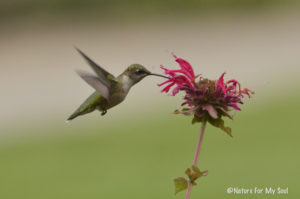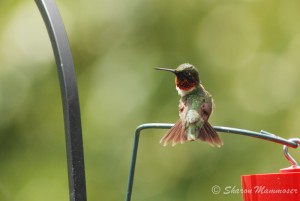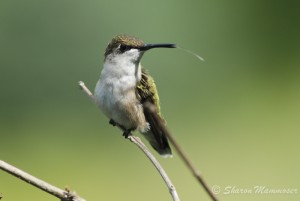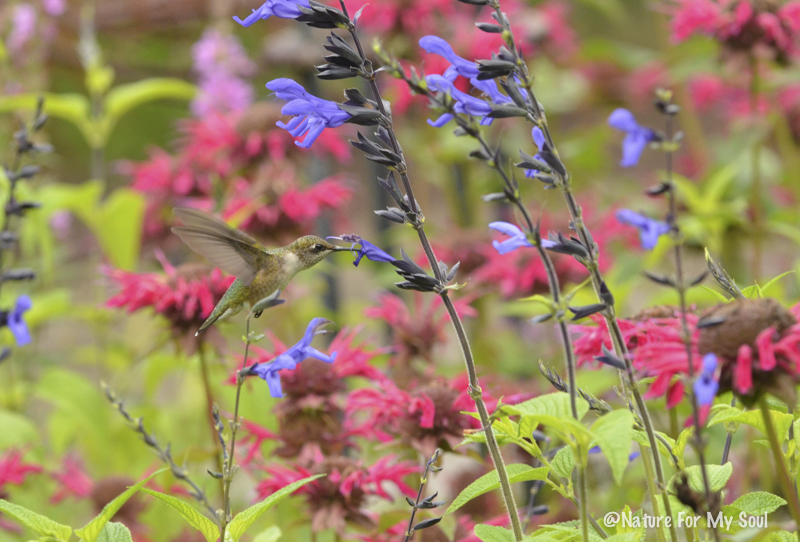One of my favorite things about summer is getting to watch the ruby-throated hummingbirds. I love watching them at my window feeder, which I put on my office window at eye level so that when the bird visits, it is just 3 feet from my eyes! While I am working I may get distracted by them but I never tire of seeing them.

So let’s talk about ruby-throated hummingbirds. Here are 10 things you may not know:
1. Ruby-throated hummingbirds weigh .141 ounces. They are the tiniest birds in the world! For reference, a penny weighs 0.88 ounces. That is amazing, especially when you watch the birds fly around through heavy rain or in strong winds. The brain of a hummingbird consists of 4.2% of their body weight; the largest in the animal kingdom! They can hear better than humans, see better than us, even see ultraviolet light.
2. Hummingbirds have the fastest metabolism of any animal on earth. Their metabolism is 100 times faster than that of an elephant! No wonder they need to eat so often! (every 15 minutes)
3. Ruby-throated hummingbirds beat their wings 60-80 times per second. But the word “beat” is really not quite correct, as they don’t beat their wings up and down like other birds. Instead, their wings move in a figure eight shape. When they are in a courtship dive, this increases to 200 times per SECOND! Have you ever seen them do this! It’s incredible! The female rests on a branch while the male flies at top speed in a giant arch, a pendulum, with the bottom being right beside the watching female. Have you ever seen this? It looks like he is on a string with someone holding it at the top and whipping it around like a yo-yo. And by the way, the humming sound their wings make when moving in this figure eight is the reason they are called HUMMING birds.
4. Their heart beats at a rate of 615 beats per minute! In comparison, the average human heart beats between 60 and 100 times in one minute.

5. Hummingbirds fly up to 40 mph in a straight line and as much as 65 mph in their courtship dive!
6. Ruby-throated hummingbirds, like other hummingbirds have a diet of flower nectar and insects and other small invertebrates that are important sources of protein for the tiny birds. They catch the insects in mid-air, find them on leaves or in spider webs. So that feeder you put out to attract them only supplements their diet.
7. The average hummingbird consumes 1/2 of it’s body weight in nectar each day! They have long narrow beaks that are hollow in the middle to allow for their long tongue–which is grooved on the sides– to slip in and out easily.

They get their nectar from flowers, and in areas where people live, from hummingbird feeders. If you want to attract hummingbirds, you can put out a hummingbird feeder. Click HERE for more information about attracting hummingbirds to your yard.
8. They are the only bird that can fly backwards and upside-down.
9. Ruby-throated hummingbirds are the only species of hummingbirds that lives and nests east of the Rockies. Thus, when you see one on the east coast, you can be pretty sure it’s a ruby-throated hummingbird! Both males and females have a metallic green back and white underside. Females are 15-25% larger, lack a red throat patch (called a gorget) and have three white-tipped tail feathers on each side of their forked tail. Immature hummingbirds lack the red gorget until after their first winter, though they may have streaking on the neck or one or two red feathers.
10. The colors you see in a hummingbird’s feathers are not from pigments, but rather the STRUCTURE of the feathers! The colors vary according to how much light hits them and at what angle it comes from. This explains why sometimes the male’s gorget looks black and then when he suddenly turns his head, it can look bright red. Amazing!!
Check out this hummingbird at my window feeder–you can really get a good look at his iridescent red gorget (fancy word for neck)


